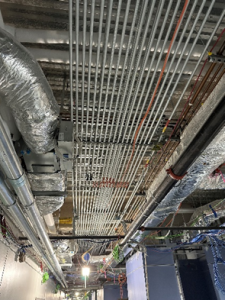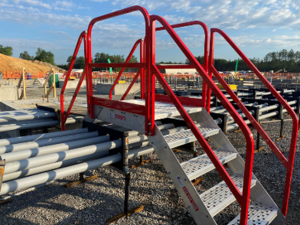Recognized by OSHA, the Ladders Last philosophy has become a standard in the construction industry. The idea behind Ladders Last is to keep team members safe by requiring work platforms such as a boom or scissor lift, and only using ladders as a last resort.
A People-First Approach
Like most large General Contractors in the industry, Gilbane adopts and enforces the Ladders Last policy. While it is inevitable to have ladders for unavoidable circumstances or tight spaces, like changing a light bulb in a finished electrical closet, project teams understand and abide by ladders being the last resort. If using a ladder is the only option, an employee submits a ladder permit to complete a task. The ladder permit will be evaluated and use approved upon review of the circumstances.
During Gilbane’s recent push to enforce this policy more widely across six of our New York City job sites, ladder use has decreased by 71 percent. Gilbane is taking a hard look at what has the potential to injure the team members executing work on our projects and removing that tool or condition off our sites helps.
Ladder falls will continue to decline on Gilbane project sites as ladder use continues to decrease. As the quote states, hung in the Gilbane main office, “If you eliminate the condition, you eliminate the incident.”
Ladder Alternatives
Offering alternatives to using ladders on-site is imperative to its success. Our in-house safety professionals are constantly researching ladder alternatives. The most common include scissor lifts, boom lifts, rolling scaffolds, temporary flooring, and platforms.
Implementing prefabrication on our projects has also been instrumental in eliminating hundreds of potential falls. In the past, electricians would work from ladders to install hundreds of feet of conduit. By using prefabrication, a Gilbane project teams design workstations to complete assembly of materials on the ground that can simply be lifted into place, eliminating the chance of ladder falls. Gilbane has also begun to use prefabricated stairs more widely, rather than conventional ladders, to get to upper levels or into excavations. These stairs are rugged enough for a construction site, and the treads are gimbaled, meaning they are steady and level when installed. These prefabricated stairs result in workers being able to get in and out of areas much easier, are safer than a ladder, and unlike ladders, workers can carry tools when using them.

At Gilbane’s Wynn project in Utica, complex ceiling assemblies are being done on the floor and then simply lifted into place. By re-designing how we work, we can prevent incidents from ever taking place.
Light-weight, low-level access lifts are a popular option across the country due to their ability to be placed on a scaffold or temporary flooring and are carbon-free. One of the biggest advantages to working off a work platform is that they are 3x more efficient than a ladder.
As eliminating ladders has become more common across job sites, project superintendents recognize the inefficiency of a ladder. It is a trend to see ladders be removed from sites and replaced with platforms in the interest of efficiency. This was one of the largest drivers for increasing lifts -not ladders- on worksites.
One of the most commonly used lifts is the EcoLift by JLG, as it takes minimal effort to move and only requires the turn of a wheel to adjust it up and down for height. It does not require power and meets the LEED credits for zero-emissions and safety. This lift will continue to be demonstrated around New York City project sites to show their advantages over ladders. Gilbane will also have these lifts and stairs available during 2023 Safety Week on job sites and the main office.

One unique ladder alternative option modeled at our Carnegie New York Public Library 125th Street project was a lift specifically designed by MEC to replace ladders. This lift has a footprint of a 10-foot ladder and can allow the user to go through a ceiling tile space to work. When displayed at the library project, the project superintendent determined that using this lift would replace the need to install a “dance floor” or temporary working deck, ultimately saving the project approximately $100,000.
As we remove ladders from our project sites, we move from managing risk to eliminating risk. Due to our enforcement of the Ladders Last policy, ladder falls continue to decline in the US and here in New York City. The idea of “Ladders Last” will save lives and is now a recognized approach across the industry. While a ladder may be the easiest option for certain on-site tasks, the ease does not outweigh the risk. Replacing ladders with more stable, efficient and reliable platforms to work from, makes for a safer and more comfortable workforce.

